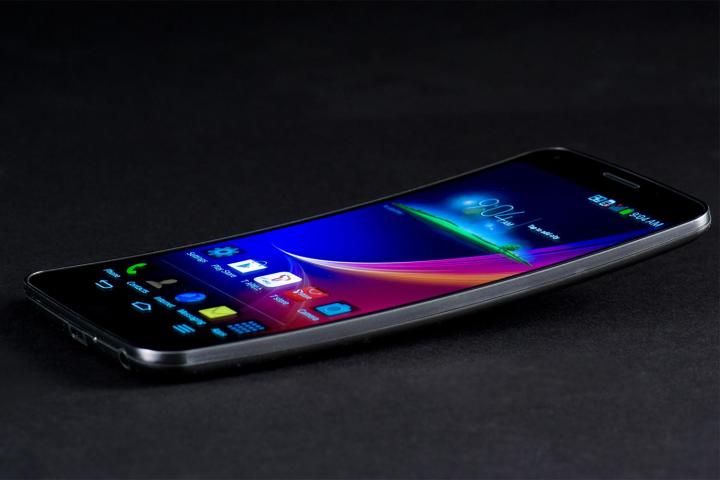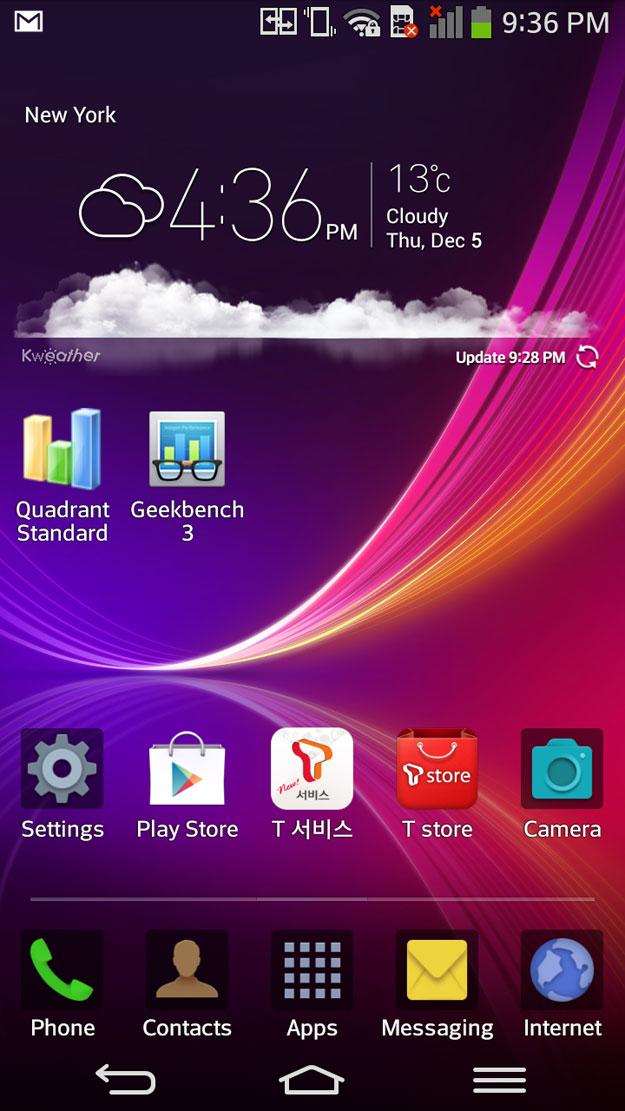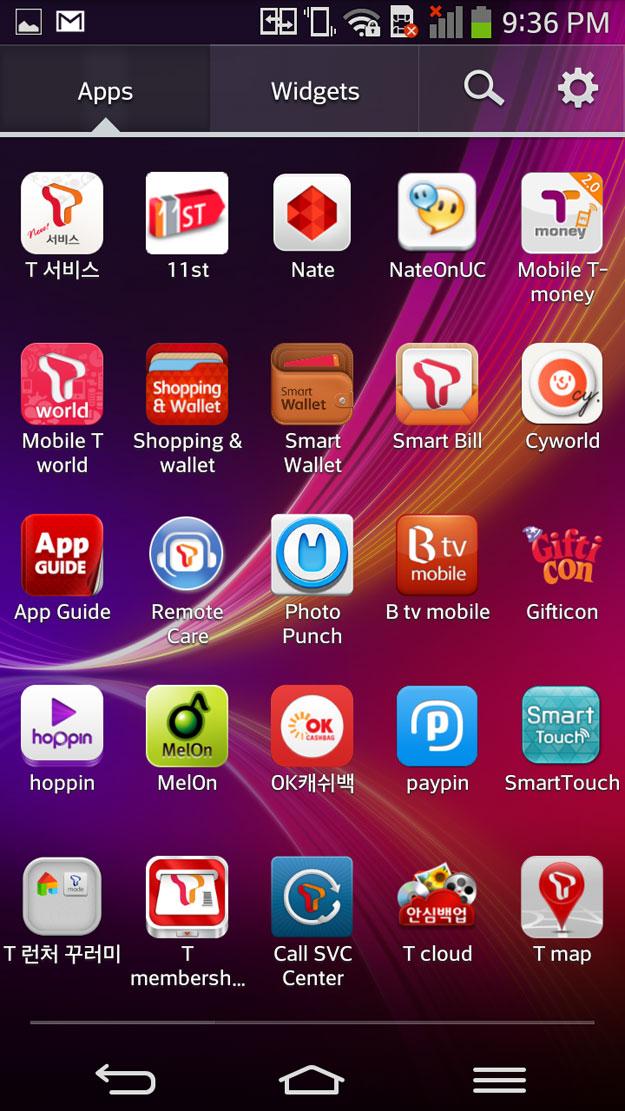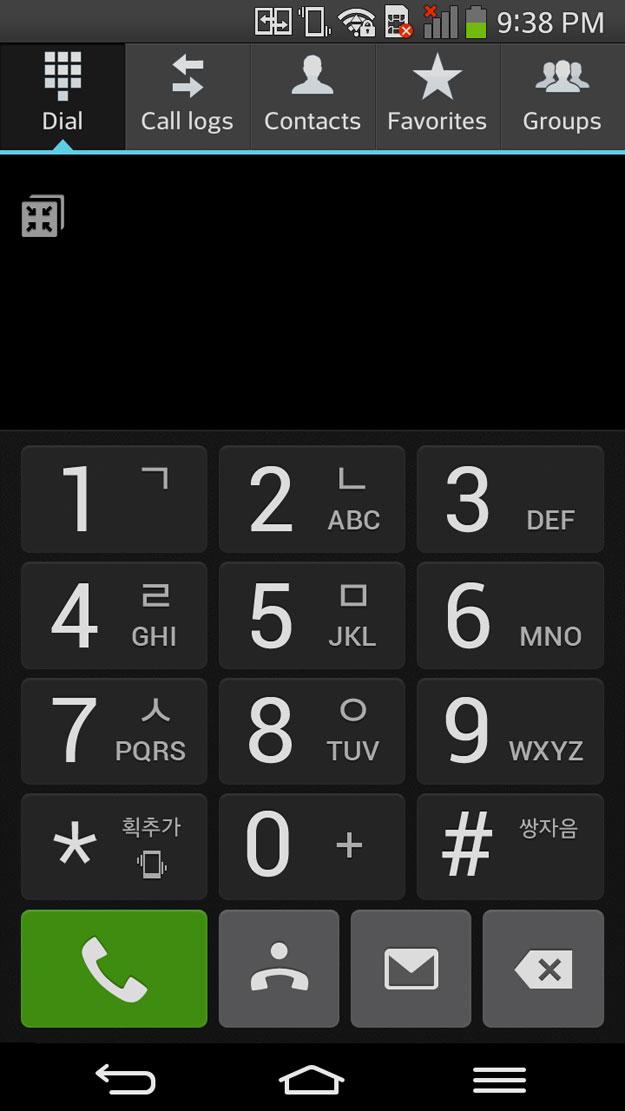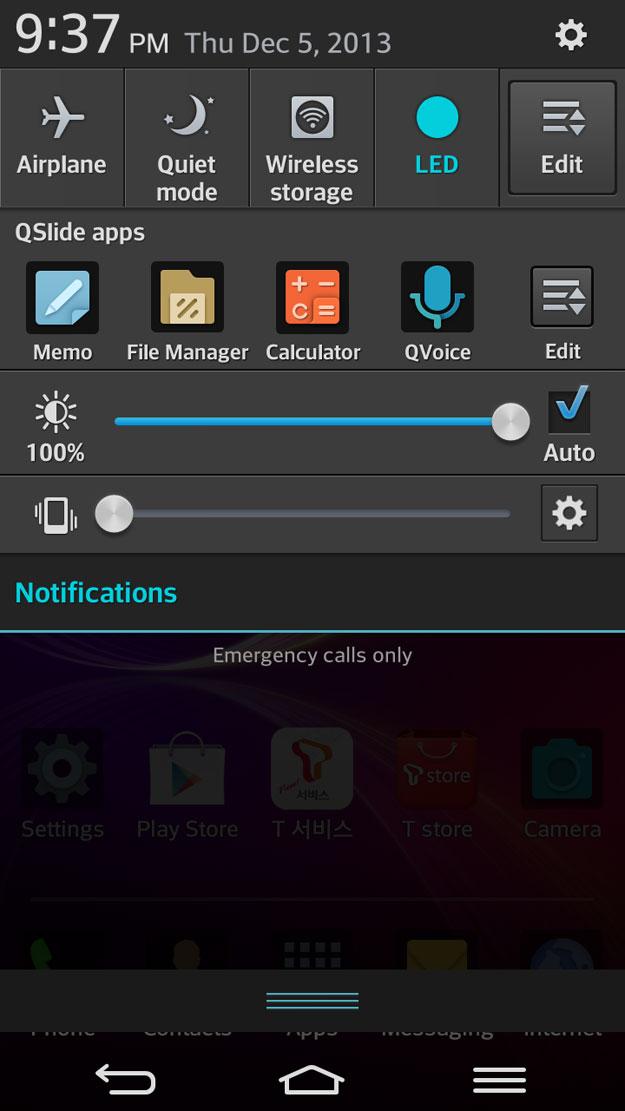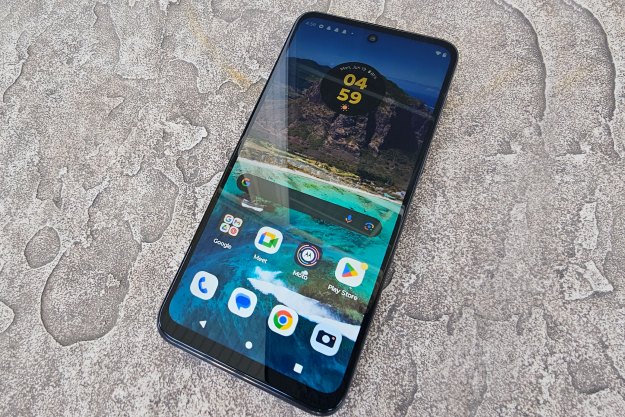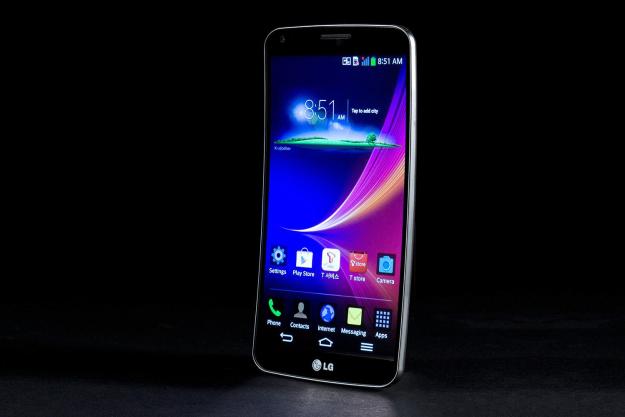
“Thanks to its curved design, the LG G Flex is the first six-inch phone that we want to hold. It also has a better battery (two to three days) and more processing power than any phone out there.”
- Most powerful phone we’ve tested
- Very comfortable for a 6-inch phablet
- 2- to 3-day battery life
- Gorgeous curved OLED screen
- Great rear speaker
- Too expensive
- No built-in stylus
- OLED screen has a grainy background
- Too big for some hands
- Scratch-healing doesn’t work well
LG may have just released the G2, but it doesn’t seem content to stand still. Like Samsung, LG is always experimenting, and the G Flex is the latest creation to spring from its labs. The G Flex is LG’s biggest phone yet, with a 6-inch screen that’s curved and a few other little tricks. But can a lot of small gimmicks add up to make a good phone? We’ve been testing the G Flex for the last few days to find out.
The first 6-inch phone we want to hold
If you buy a Galaxy Note 3 or its other gigantic contemporaries like the HTC One Max, you’re putting up with their enormity for the sake of some screen real estate. They aren’t all that comfortable to hold. They’re like giant tiles: big, square, and flat.
I’ve never made the leap to a phablet-sized phone. They’re just too big for me. But after using the G Flex, I may have found a phone that manages its size well.
The G Flex is the most comfortable phablet I’ve ever held.
Thanks to the curved screen – which bends top to bottom like a banana – and LG’s button placement, the G Flex is the most comfortable phablet I’ve ever held.
The curve of the screen is subtle and the overall design feels a lot like a bigger, better Galaxy Nexus. Remember that phone? Like the G Flex, it supposedly had a curved (not that you could tell) OLED screen with a peculiarity to it. That’s where the similarities end, though. As we’ll discuss later, the G Flex has the battery life of two or three Galaxy Nexus’s.
So why is it comfortable? Believe it or not, that small curve helps. Instead of your hand molding around a rigid brick, the G Flex bends with it. It’s far more comfortable to hold to your face and take calls than an HTC One Max.
Like the LG G2 (our favorite Android phone of 2013), the power and volume buttons on the G Flex are on its back, directly in the center. Every other phone you’ll use has volume and power buttons on the sides. LG’s decision to move these buttons will jar you at first, but it makes life with a giant 6-inch phone far easier. It’s more of a stretch than on the G2, but thanks to the power and volume button placement, you can press them while also reaching the navigation buttons (Home, Back, Menu) with your thumb. You can also reach up and pull the notification window down without shuffling your grip. At some point, shuffling a phone around your palm always leads to a drop, so we’re glad LG takes grip and hold so seriously.
Finally, LG’s KnockOn feature, which lets you turn the phone screen on or off by tapping on it twice, also makes one-handed use more possible, as does the option to shrink the keyboard.
For a massive phone, the G Flex is remarkably comfortable. Did we mention the power button lights up? We have no reason to, but we like it.
So, what about that curved OLED screen?
There’s no practical reason why you’d want to look at a curved screen, but it is fresh. Looking at videos and items scroll further and closer to you as they move up and down the screen brings with it a small, subtle joy. We found it a little jarring to go back to flat screens after using the curved G Flex. There’s nothing technically superior about it; it’s just different. We don’t think it will bother you or blow you away.
Though LG has heavily criticized Samsung for using AMOLED screens, the G Flex does have an OLED display. You can tell when you’re using an OLED screen because the colors are sometimes more saturated (some say too vivid, to the point of discoloration) and blacks are extremely black. On LCD screens, when black is displayed, it’s still being shown on a lit-up pixel. In OLED, because each pixel is lit independently, black pixels are actually completely turned off. You can’t get blacker than that.
We found it a little jarring to go back to flat screens after using the curved G Flex.
We like the OLED screen on the G Flex, but its 1280 x 720 pixel resolution is a step down from 1920 x 1080 pixel displays seen in most high-end phones, including the G2. We’re blaming the curve for this. You’ll also have to get used to a grainy texture in the background. Like the Galaxy Nexus (and some other AMOLED devices) there is a noticeably grain behind all your screens. This doesn’t bother us, but it might bother you. Make sure to hold and look at menus on the phone (the keyboard is a good test) to make sure it doesn’t drive you nuts.
Small bonus: Thanks to the curve of the screen, the G Flex will (barely) stand up on its side, making Netflix and Hulu watching much easier.
About the “Flex” and healing in G Flex …
One of the G Flex’s tricks is that if you set it screen down, you can put up to 88 pounds of pressure on it and it will bend, not break. We tried this out and … success! It does flex a few millimeters and appears more durable than non-curved phones in that way. LG has employed special types of batteries to achieve this bendability.
The other super power that LG touts is the ability for the plastic back of the phone to heal itself. There’s a special, urethane-like coating on the plastic that apparently re-aligns its own molecules to repair small scratches. This may save your phone from a scratch or two in your pocket, but we were more impressed with the feature in this video than in practice.

In reality, it felt like the coating on the back of the G Flex is more prone to small scratches than other phones. This is fine, because with a few minutes to a few hours (depending on if its warm outside), these scratches seem to disappear. We also made the mistake of putting a key to the phone a little more directly. If you cut through the thin self-healing film, no amount of molecule reorganizing is going to save your phone.
It’s fun to have a phone that flexes and heals, but these are not reasons to buy the LG G Flex. They won’t help you out in a bind.
A new interface built for a new screen
In an attempt to add more black to its design and take advantage of the gorgeous color that can come from an OLED display, LG redesigned its TouchWiz interface for the G Flex. It now looks a lot like Google’s default Android design, with more pizazz. Icons are simpler and colored in pastels, and there’s a lot more transparency throughout the interface. LG attempts to make it look like the grainy background is party of the interface as well, which is good. Mostly, things operate the same as the LG G2 and Optimus G Pro. If you’ve used a Samsung Galaxy phone in the last couple years, nothing will be rocket science to you.
We’re disappointed that the G Flex is only running Android 4.2, especially since it’s a year old now and
As usual, the big downside to an LG or Samsung phone is the amount of bloatware. We were shocked when the LG G2 came with 62 apps preinstalled, but the G Flex blows this away. There are 84 apps pre-installed on this device, taking up 8GB of the 32GB of onboard memory. Most of them are unneeded. Again, we hope the American version will have less bloatware.
Powerful
The G Flex is powerful. We’ve already talked about its 6-inch 1280 x 720 pixel OLED screen, but under the hood it packs a punch with 2GB of RAM, a 13-megapixel camera, and a 2.26GHz quad-core Snapdragon 800 processor, which is the best gig in town right now. The rear speaker is also fairly clear and powerful for a phone.
We have yet to find an app or situation that will bog the G Flex down.
We can’t say with any accuracy how powerful it is anymore because LG is probably juicing its benchmarking stats like Samsung and HTC. Regardless, in our Quadrant test, the G Flex came out with a 19,825, making it the second highest scoring phone we’ve tested yet, outpacing the LG G2 by a couple thousand points and narrowly losing to the Galaxy Note 3, which managed to break 20,000 (or so we think). Most high-end phones this year achieve scores of about 9,000 to 14,000.
In practical use, we found the G Flex to be extraordinarily snappy and fast. We have yet to find an app or situation that will bog it down. In the past, LG’s camera app has proven a little tricky for its phones, but here it can focus on nine things at once with no problem.
We haven’t spent enough time with the G Flex to fully rate its battery performance, but with a 3,500mAh battery and an OLED screen, we believe LG’s claims of two to three days of battery life on a single charge. Other than a Droid Maxx, there is no other phone that likely matches the battery life in the G Flex. More than anything, this is a big reason to consider buying it.
Camera
The camera in the G Flex appears to be the same one that was in the LG G2, meaning it’s a fast and effective 13-megapixel shooter. We didn’t experience the lag and slowdown when attempting to use 9-point auto-focus like we did in the G2, and most of our shots came out as good as you’d expect on a bland, cloudy day.
Though it doesn’t hold a candle to the 41-megapixel shooter on the Nokia Lumia 1020 (no phone does), we did find the low-light performance on the G Flex to be better than average. You’re not going to see in the dark here, but LG picked up about as much light as our unadjusted eye did in dark situations.
Conclusion
The G Flex is a fantastic phone, and the first phablet to ever feel natural in our hand. We do wish it had the stylus features of the Galaxy Note series, but LG has packed a lot into this device. It gets 2-3 day battery life, has a fun curved OLED screen, can withstand some bending, has a new interface, and it’s the fastest phone out there. The only downside is that it costs the equivalent of $940 in Korea. We are hoping it will come to the United States soon. If it’s priced down near the $700 range, LG may just put the Galaxy Note 3 on notice.
Highs
- One of the most powerful phones we’ve tested
- Very comfortable for a 6-inch phablet
- 2- to 3-day battery life
- Gorgeous curved OLED screen
- Great rear speaker
Lows
- Too expensive
- No built-in stylus
- OLED screen has a grainy background
- Too big for some hands
- Scratch-healing doesn’t work well
Editors' Recommendations
- Is the Moto G Stylus waterproof?
- 5G home internet: What is it, and should you get it?
- Visible just made its unlimited 5G plan better than ever
- The best Moto G Power 5G (2024) cases: 7 great choices
- How fast is 5G? What you need to know about 5G speeds

